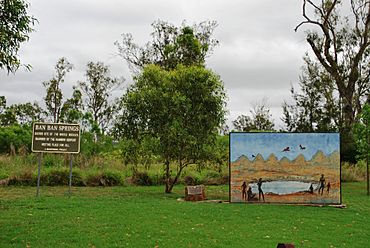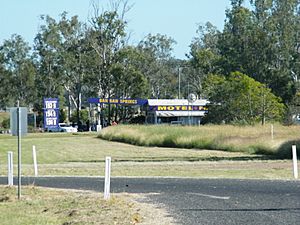Ban Ban Springs facts for kids
Quick facts for kids Ban Ban SpringsQueensland |
|||||||||||||||
|---|---|---|---|---|---|---|---|---|---|---|---|---|---|---|---|
 |
|||||||||||||||
| Population | 31 (2021 census) | ||||||||||||||
| • Density | 1.520/km2 (3.94/sq mi) | ||||||||||||||
| Postcode(s) | 4625 | ||||||||||||||
| Elevation | 130–310 m (427–1,017 ft) | ||||||||||||||
| Area | 20.4 km2 (7.9 sq mi) | ||||||||||||||
| Time zone | AEST (UTC+10:00) | ||||||||||||||
| Location | |||||||||||||||
| LGA(s) | North Burnett Region | ||||||||||||||
| State electorate(s) | Callide | ||||||||||||||
| Federal Division(s) | Flynn | ||||||||||||||
|
|||||||||||||||
Ban Ban Springs is a small rural area in Queensland, Australia. It's part of the North Burnett Region. In 2021, only 31 people lived here. This place is special because of its natural springs, which are very important to the local Aboriginal people.
Contents
Where is Ban Ban Springs?
Ban Ban Springs is like an island of land. It's completely surrounded by a larger area called Ban Ban. A creek called Barambah Creek flows along part of its southern edge.
Two main roads meet here. The Burnett Highway comes in from the west and goes south. The Isis Highway comes from the east and ends when it joins the Burnett Highway.
Right near where these highways meet, you'll find the natural springs. These springs are rare because their water flows into the nearby Barambah Creek. The area is mostly used for grazing animals on natural grass, but some crops are grown too.
A Look at History
The name Ban Ban Springs comes from H. Herbert. He leased the land around the springs in 1846. He used the words "Ban Ban" which mean grass in the local Wakka Wakka and/or Kabi Kabi languages.
A school called Ban Ban Springs State School opened in August 1916. It taught children for many years before closing on January 24, 1965. The old school was located on the south-western side of the Burnett Highway.
Who Lives Here?
In 2016, only 7 people lived in Ban Ban Springs. By 2021, the population grew to 31 people.
Learning and Schools
There are no schools directly in Ban Ban Springs today. For primary school, kids usually go to Coalstoun Lakes State School in Coalstoun Lakes. For high school, the closest option is Burnett State College in Gayndah.
Special Aboriginal Heritage
The natural springs at Ban Ban Springs are very important to the Wakka Wakka people. They are the first Aboriginal cultural heritage site in Queensland to be officially recognized under a special law.
The Wakka Wakka people believe the springs are sacred and connected to their Dreaming stories. A study confirmed this, with advice from the Wakka Wakka Jinda (elders). The springs were added to the State's Aboriginal Cultural Heritage register for these reasons:
- The springs are a sacred place.
- They are linked to the Rainbow Serpent, a powerful being in Aboriginal stories. The Rainbow Serpent is believed to have appeared there and shared secrets about the sacred waters with the elders.
- Many Wakka Wakka elders were born at Ban Ban Springs.
- The springs are important for both men's and women's traditional business and ceremonies.
- The Rainbow Serpent has protected this area for a very long time.
Sadly, in 2006, the local council tried to clean up the area around the springs. They wanted to remove weeds and make it nicer for visitors. However, they accidentally damaged some of the cultural heritage. They cleared plants, moved rocks, and drove through the springs. This upset the Wakka Wakka people because it harmed their sacred site.
After this happened, the Queensland government took action. They started discussions between the council and the Wakka Wakka people to fix the damage and manage the area better. The council later said they were sorry for the harm caused and agreed to work with the Wakka Wakka people.
The springs don't always have water flowing. Sometimes they are dry, and nearby irrigation for farming has also reduced the water available.




